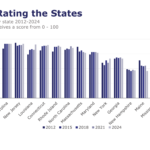Two new studies suggest renters living along the East and Gulf coasts of the United States face rent increases, higher eviction rates and a lack of affordable housing in the aftermath of a hurricane impacting the more than 44 million American households living in rental dwellings currently.
The research was presented at the annual meeting of the 2023 Society for Risk Analysis Annual Conference in Washington, D.C.
Both analytical studies are based on 10 years of data (2009-2018) on housing, hurricane disasters and socioeconomic factors at the county level in 19 coastal states. The time period includes devastating hurricanes such as Irma (2011), Sandy (2012) and Matthew (2016).
Dr. Kelsea Best of The Ohio State University and her colleagues analyzed how the frequency and intensity of a hurricane correspond to changes in median rent and rental housing affordability over time. According to their analysis, median rents rise in the year following more intense hurricanes due to declines in housing availability.
Their results also suggest that the occurrence of a hurricane in any given year (or in the previous year) reduces affordable rental housing, especially in counties with a higher percentage of renters and people of color. Renters also have reduced access to post-disaster government aid programs and benefits from federal mitigation programs, such as home buyouts.
“Most federal post-disaster assistance programs are targeted to homeowners,” Best said. “Our study shows that deliberate attention must be given to renters — especially low-income and minority renters — in recovery efforts immediately following a disaster event and in subsequent years.”
These could include eviction moratoriums, limiting late fees on rent payments, increasing access to emergency rental assistance and freezing rent increases.
“Without such deliberate consideration of rent and renters, disaster recovery risks exacerbate the affordable housing crisis for some of the most vulnerable populations,” Best added.
In addition, people of renter status are more likely to be underinsured, with only 57 percent having insurance policies as of 2022, according to statistics by the Insurance Information Institute
In another study, Dr. Qian He of Rowan University and her colleagues investigated how disasters and post-disaster federal aid contribute to renters’ eviction risks. They found that hurricanes corresponded to higher eviction filings and eviction threats by inflating market rent the year of and one year after the hurricane.
Counties receiving higher amounts of aggregated federal aid (both post-disaster and hazard mitigation aid) were associated with lower eviction filings and eviction threats two years after the disaster. According to He, this suggests that post-disaster federal aid programs can help mitigate renters’ housing vulnerability during disaster recovery.
“Our findings indicate that coordinated public policies and renter aid programs, specifically after disaster events, can become crucial to ensure that at-risk communities have access to sufficient financial resources and legal support to help renters avoid eviction,” He said, the Centers for Disease Control’s national eviction moratorium during COVID-19.
The act provided immediate relief for over 6.5 million renter households across the country who were behind on their rent payment and those who were at an increased risk of eviction.




















 Lockton Re: Hypothetical Cyber Event Offers Carriers an Opportunity to Review Risks
Lockton Re: Hypothetical Cyber Event Offers Carriers an Opportunity to Review Risks  P/C Insurance Execs, Underwriters Out of Sync on Advanced Tech
P/C Insurance Execs, Underwriters Out of Sync on Advanced Tech  IBHS: Virginia Edges Florida Out of First Place in Building Code Adoption
IBHS: Virginia Edges Florida Out of First Place in Building Code Adoption  Allstate Will Insure California Homes Again, Under One Condition
Allstate Will Insure California Homes Again, Under One Condition 